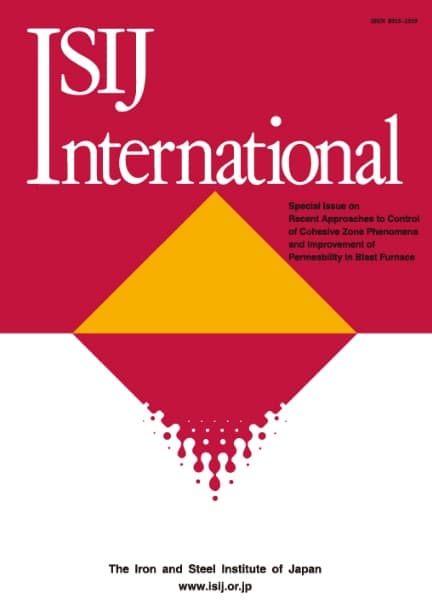Effect of Fe2O3 on Coke Solution-Loss under a CO2+H2O Atmosphere— A Kinetics Study
Zhiyang Feng, Minghui Dou, Jiawei Han, Zhang Sun
他の人はこちらも検索
ISIJ International 早期公開
ISIJ International 早期公開
ISIJ International 早期公開
ジャーナル


Grid List Abstracts
| オンライン版ISSN: | 1347-5460 |
| 冊子版ISSN: | 0915-1559 |
| 発行機関: | The Iron and Steel Institute of Japan |
Backnumber
Vol. 65 (2025)
Vol. 64 (2024)
Vol. 63 (2023)
Vol. 62 (2022)
Vol. 61 (2021)
Vol. 60 (2020)
Vol. 59 (2019)
Vol. 58 (2018)
Vol. 57 (2017)
Vol. 56 (2016)
Vol. 55 (2015)
Vol. 54 (2014)
Vol. 53 (2013)
Vol. 52 (2012)
Vol. 51 (2011)
Vol. 50 (2010)
Vol. 49 (2009)
Vol. 48 (2008)
Vol. 47 (2007)
Vol. 46 (2006)
Vol. 45 (2005)
Vol. 44 (2004)
Vol. 43 (2003)
Vol. 42 (2002)
Vol. 41 (2001)
Vol. 40 (2000)
Vol. 39 (1999)
Vol. 38 (1998)
Vol. 37 (1997)
Vol. 36 (1996)
Vol. 35 (1995)
Vol. 34 (1994)
Vol. 33 (1993)
Vol. 32 (1992)
Vol. 31 (1991)
Vol. 30 (1990)
Vol. 29 (1989)
15 Dec. (Last 30 Days)
Zhiyang Feng, Minghui Dou, Jiawei Han, Zhang Sun
他の人はこちらも検索
ISIJ International 早期公開
ISIJ International 早期公開
ISIJ International 早期公開
Katsuhiro Sasai
他の人はこちらも検索
ISIJ International 早期公開
ISIJ International 早期公開
ISIJ International 早期公開
Shinichi Furuya, Tadachika Chiba, Daisuke Mizuno
他の人はこちらも検索
鉄と鋼 早期公開
Hannah Lomas, Salman Khoshk Rish, Tara Congo, Karen Steel, Apsara Jayasekara, Arash Tahmasebi
他の人はこちらも検索
ISIJ International 早期公開
ISIJ International 早期公開
ISIJ International 早期公開
Fuhai Liu, Jialin Guo, Bin Tong, Rong Zhu, Guangsheng Wei, Kai Dong
Chaofa Zhao, Yang Li, Changgui Cheng, Xufeng Qin, Xingyu Huang, Zilong Jiang
Tomotsugu Shimokawa, Kanta Kikugawa
他の人はこちらも検索
ISIJ International 早期公開
ISIJ International 早期公開
ISIJ International 早期公開
Guangwei Wang, Junyi Wu, Guojun Sun, Andrey Karasev, Zheng Ren, Xueting Zhang, Xiaojun Ning, Chuan Wang
Yang Yu, Chang Wang, Lin Wang, Yajun Hui, Xudong Li, Liangliang Zhang
Hiroshi Kakinuma, Yoshinori Sasaki, Saya Ajito, Motomichi Koyama, Eiji Akiyama
他の人はこちらも検索
Shohei Ueki, Koyo Tsunoda, Toshiyuki Kondo, Shigeru Hamada
他の人はこちらも検索
Ceng Li, Guangsheng Wei, Rong Zhu, Fuhai Liu, Chengjin Han, Linghui Meng
Sien Liu, Karel Blanken, Jiaqiang Dang, Fabien Briffod, Wujun Yin, Shoichi Nambu
Lin Zhao, Jieping Wang, Wenjia Hu
Kenichi Nakayama
Seong-Gi Kim, Seok-Eui Lee, Chang-Hyun Wee, Hyun-Seok Jeong, Jong-Eun Lee, Kyung-Ho Seo, Sang-Min Byon, Youngseog Lee
Zhijian Zhao, Weiguo Li, Xuefeng She, Fengming Guo, Jingsong Wang, Qingguo Xue
Kenya Horita, Kenta Takehara, Yuji Iwami, Takahide Higuchi, Tetsuya Yamamoto
Yangqi Li, Yanping Luo, Zhanguang Han, Wei Li, Ming Yang, Hao Tang, Guangrong Li, Wei Min
Linhao Huang, Shilong Kuang, Jingchao Guo, Jing Zhang
Anna Eriksson, Hesham Ahmed, Daniel Marjavaara, Charlotte Andersson, Telkicherla Kamesh Sandeep Kumar, Pär Semberg
Sangbum Woo, Yeo-Jun An, Joong-Ki Hwang
他の人はこちらも検索
ISIJ International 早期公開
ISIJ International Vol.65(2025), No.13
Yongda Li, Renhao Tian, Ningyu Zhang, Guishang Pei, Yuxiao Xue, Xuewei Lv
他の人はこちらも検索
ISIJ International 早期公開
ISIJ International Vol.65(2025), No.13
Michihiko Nagumo
Tomohiko Omura, Misaho Yamamura, Kazuma Ito, Junichiro Yamabe, Hisao Matsunaga
Shohei Ueki, Tsuyoshi Mayama, Yoji Mine
Norimitsu Koga, Kotaro Tanabe, Hiroyuki Kawata, Naoki Maruyama
Ko-ichiro Miyamoto, Tatsuo Yoshinobu
他の人はこちらも検索
ISIJ International Vol.65(2025), No.12
ISIJ International Vol.65(2025), No.12
ISIJ International Vol.65(2025), No.13
Motomichi Koyama, Yongxin Wang, Rama Srinivas Varanasi, Takuro Masumura, Toshihiro Tsuchiyama
Yelm Okuyama, Tetsuya Ohashi
Masaharu Takagi, Masaki Tanaka, Tatsuya Morikawa, Shigeto Yamasaki, Takanori Ito, Shigenobu Nanba
他の人はこちらも検索
ISIJ International 早期公開
ISIJ International 早期公開
ISIJ International 早期公開
Norimitsu Koga, Masaru Sakurai, Osamu Umezawa, Huyen Thi Doan, Sota Goto
他の人はこちらも検索
ISIJ International Vol.65(2025), No.11
Zisong Guo, Tomohiko Hojo, Hiroyuki Saitoh, Ayumi Shiro, Takahisa Shobu, Ryo Yasuda, Saya Ajito, Motomichi Koyama, Eiji Akiyama, Fumio Yuse, Makoto Kawamori
他の人はこちらも検索
ISIJ International 早期公開
ISIJ International Vol.65(2025), No.8
ISIJ International 早期公開
Tomohiko Hojo, Akihiko Nagasaka, Ryusei Wakabayashi, Chihaya Tabata, Yota Kondo, Kazuma Ogasawara, Yuki Shibayama, Eiji Akiyama
他の人はこちらも検索
ISIJ International 早期公開
ISIJ International 早期公開
ISIJ International Vol.65(2025), No.10
Tomohiko Hojo, Akihiko Nagasaka, Chihaya Tabata, Yuki Shibayama, Junya Kobayashi, Eiji Akiyama
他の人はこちらも検索
ISIJ International 早期公開
ISIJ International 早期公開
ISIJ International Vol.65(2025), No.10
Yuri Sugiyama, Kenichi Takai
他の人はこちらも検索
ISIJ International 早期公開
ISIJ International 早期公開
ISIJ International Vol.65(2025), No.10
15 Dec. (Last 30 Days)
鉄と鋼 早期公開
ISIJ International Vol.65(2025), No.2
ISIJ International Vol.43(2003), No.9
ISIJ International Vol.52(2012), No.12
ISIJ International Vol.65(2025), No.12
ISIJ International 早期公開
この機能はログイン後に利用できます。
下のボタンをクリックしてください。
出版日を西暦で入力してください(4桁の数字)。
検索したいキーワードを入力して下さい